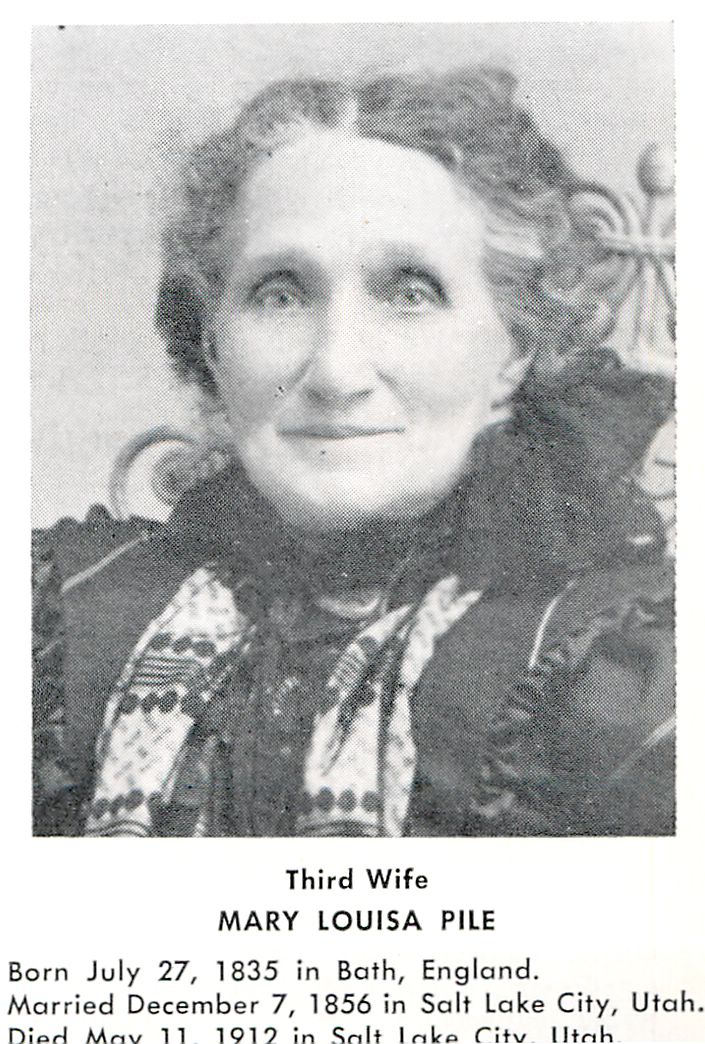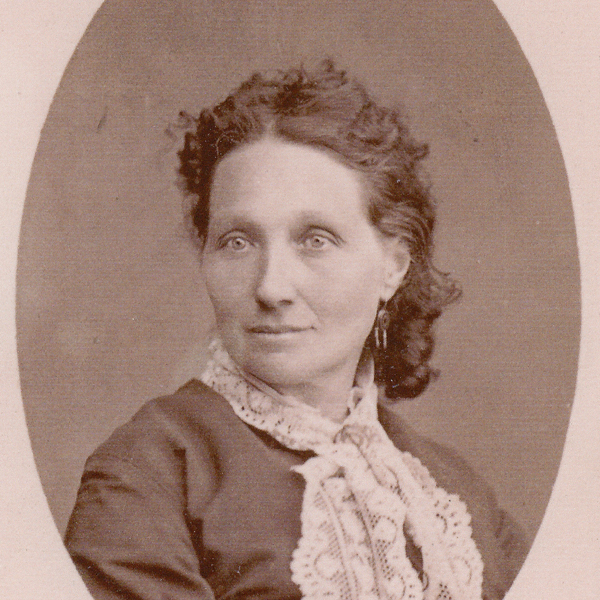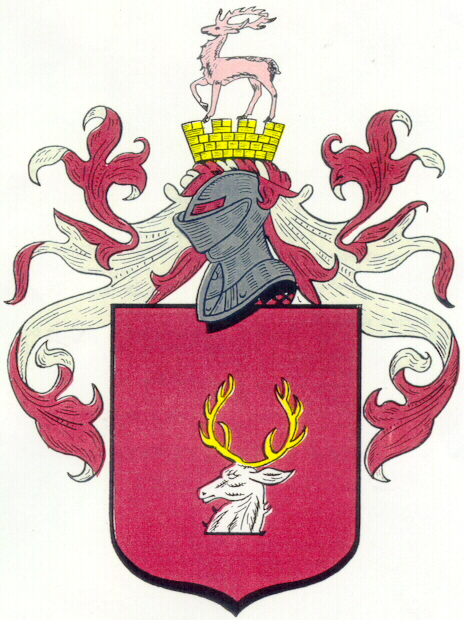
Nathaniel Henry Felt
A Pioneer of the first order
Mary Louise Pile
On December 7,
Each of her children served as missionaries.
Additionally, she was a member of the Tabernacle Choir.
Among her friends and close associates were Brigham Young and family (her daughter, Mary Adelia married
Children of those associates she knew remembered her as “Aunt Polly”.
In fact, Paul Ernest Felt’s mother, Mae Felt (Ernest William Felt’s wife) would in later life refer to Mary as Grandma Silver.
First Alderman
Nathaniel was not the
He was the first Alderman of Salt Lake City and also a member of the first Territorial Assembly.
Nathaniel arrived in the fall of 1850.
He possessed a sound commercial mind and his instincts lifted him above his humble environment.

Mary Pile Felt
Mary Louise was also motivated to become
a doctor and thus her desire become her reality

Nathaniel Henry Felt
Son of Nathaniel and Hannah Felt
born February 6,
George Felt Jr
This document details the generation from George Felt, Jr – abt 1631 then to Nathaniel Henry Felt born in 1816. These male descendants include:
Jonathan Felt – 1667
Jonathan Felt, Jr. – 1699
David Felt – Abt 1933
Nathaniel Felt – 1771 and then
Nathaniel Henry Felt – 1816
Patriarchal Blessing
In The Church of Jesus Christ of Latter-day Saints, a patriarchal blessing is a blessing or ordinance given by a patriarch to a church member. Patriarchal blessings are modeled after the blessing given by Jacob to each of his sons prior to his death
Every worthy, baptized member is entitled to and should receive a patriarchal blessing, which provides inspired direction from the Lord. Patriarchal blessings include a declaration of a person’s lineage in the house of Israel and contain personal counsel from the Lord. As a person studies his or her patriarchal blessing and follows the counsel it contains, it will provide guidance, comfort, and protection.
Under the authority of the Holy Priesthood and by one having been Ordained as a Patriarch, John Smith provided the Patriarchal Blessing to Nathaniel Henry Felt

NH Felt back to 1631
Generations back to George Felt Jr
George Jr was the eldest son of George and Elizabeth (Wilkinson) Felt with records indicating her was baptized on Nov 11, 1639.
He married Philippa Andrews whose parents came from London in 1635
When the Indian War (King Philip’s War) broke out, George Felt was among those who fled for refuge to House Island and was killed in September 1676 will all of his companions in a gallant, but forlorn attempt to save their property on Peak’s island.
George Felt
George Felt (or Felch, as the name is sometimes spelled and originally written) came from England to Salem, Massachusetts in 1628
Wives and Children
George Felt (or Felch)
Here you are able to read something of his history.
Keep in mind, George had a life just like yours – only in a different time and place.

Mary Louisa Pile Felt
The Ancestor of Paul Ernest Felt
Nathaniel H. Felt
Nathaniel Henry Felt (February 6, 1816 – January 27, 1887[1]) was a member of the Utah Territorial Legislature and a mid-level leader of The Church of Jesus Christ of Latter-day Saints in the 19th century.
Contents
Early life
Felt was born in Salem, Massachusetts to Nathaniel Felt and his wife the former Hannah Reeves. The older Felt died when Nathaniel H. was seven. Felt studied in local schools and was a member of the Divisionary Corps of Independent Cadets[2] until age 15 when he became an apprentice to a tailor in Lynn, Massachusetts. He also clerked from about age 14 in a Salem, Massachusetts retail store for Mr. Benjamin Cox.[3] With the aid of an older brother, John Gillingham Felt, he at age 21 set up a tailor shop with multiple employees and was then involved in trade with China and parts of west Africa. Felt’s ancestry in Salem was deep and well-connected having descended from George Felt who first arrived in Salem in the year 1628 with John Endecott. On 3 October 1839 Felt married his second cousin Eliza Ann Preston. Both Nathaniel and Eliza were descendants of Bridget Bishop. The well-connected Felt family had many relatives in town and nearby; one of the most luminary examples was Joseph Barlow Felt who was Nathaniel’s much older first cousin and often-cited Massachusetts historian.
Earliest Latter Day Saint involvement
On 17 September 1843 the Felts were baptized as members of the Church of Jesus Christ of Latter Day Saints, primarily as a result of the missionary work of Erastus Snow. A likely attendee at the baptism ceremony was Brigham Young, future Presidentof the LDS Church.[4] who became a lifelong associate of Nathaniel and Eliza. In March 1844, Felt was ordained president of the Salem Branch of the Church by Erastus Snow.[5] In late spring 1844, Brigham Young sent his teenage daughter Vilate from Nauvoo, Illinois with Augusta Adams Cobb to live with the Felts in Salem in order for her to obtain a proper education.[6] By June 1844, Brigham Young and Wilford Woodruff were frequent visitors in the Felt home during their efforts to elect Joseph Smith Jrpresident of the United States. When Smith was murdered at Carthage, Illinois, Brigham Young returned to Nauvoo and became leader of the Latter-day Saints.
In late Spring 1845 the Felts moved to Nauvoo and donated carpets and furniture to be used as furnishings in the Nauvoo Temple. While in Nauvoo he was the tailor for Brigham Young, John Taylor and many other Mormon leaders in the city.[7] Felt was involved in the Battle of Nauvoo serving under the overall command of Daniel H. Wells. Shortly after this Felt became ill and so went to St. Louis, Missouri to try to regain his health, this was in the fall of 1846.
St. Louis branch presidency
In February 1847 Felt was appointed president of the St. Louis Branch. By this time the branch numbered well over 800 members. Largely due to emigration from elsewhere but also as a result of baptisms there the branch was growing even more. In March 1847 the St. Louis Conference (roughly equivalent to a District in present LDS Church organization) was organized by Felt into six ecclesiastical wards with governing council of twelve bishops to oversee emigration and relief for the poor.[8] With areas outside St. Louis added to the Conference’s jurisdiction it soon had between 3,000 and 10,000 Latter-day Saints under its watch. Besides various branches in St. Louis, Felt also supervised branches in Alton, Illinois and Gravois. Felt also oversaw the purchasing of supplies and for and the chartering of steamboats for the British Mormons who would stop in St. Louis on their way to Utah. Another major activity of Felt while in St. Louis was giving priesthood blessings, visiting and comforting the sick, and other such things during the cholera epidemic after the great fire of 1849. In the end, Felt proved himself valuable to Brigham Young who used him for many other assignments in the following years.
Move to the Utah Territory
After serving as St Louis conference president for slightly more than three years, Felt was released in 1850 and started west with his wife and three children. He crossed the plains in the Edward Hunter Company[9] which included the Heywood and Woolley Church Merchandise Train managed by Joseph L. Heywood and Edwin D. Woolley and primarily consisted of wagons carrying goods bought by the Church to try to avoid paying exorbitant rates charged by some merchants in Utah. Nathaniel would have been familiar with such enterprises having descended from great grandfather Jonathan Felt whose sons David and John Felt ran a successful shipping business from Salem.[10]
Felt arrived in Utah in October 1850 and was appointed an alderman of Salt Lake City in January 1851 by Brigham Young. In August 1851 Felt was elected to the first Utah Territorial Legislature. During the early 1850s he also helped George A. Smithin founding the town of Parowan, Utah. In the same year Felt was called as a traveling bishop of the LDS Church, with the assignment to instruct local bishops in various locations on the proper methods of processing and recording tithing and other donations.
In 1852 Felt was appointed chaplain of the Nauvoo Legion (the name then used by the Utah Territorial Militia) with the rank of colonel and standing on the general staff. In 1854 Felt entered the practice of plural marriage, marrying Sarah Strange as his second wife. In 1854-1856 Felt served as a missionary in New York City where he served as assistant editor of The Mormonunder John Taylor. During Felt’s journey back from New York he intercepted the tragic handcart companies of 1856 including the Willie and Martin group.
Later life
Later in 1856 Felt married his third and last wife, Mary Louisa Pile. He was the father of 17 children. In 1858 Felt received a contract to supply grain to Camp Floyd. He set up a grain distribution system with locations in Salt Lake City, Nephi, Utah and Ephraim, Utah. When President Abraham Lincoln died, Felt served on a committee to honor the president’s life. Soon thereafter when the Speaker of the United States House of Representatives, Schuyler Colfax, visited Salt Lake City with Massachusetts gadfly reporter Samuel Bowles, Nathaniel H. Felt was one of their hosts. Of Felt it was written, “Perhaps the most refined man of our hosts in personal appearance and manners was a Mr. Felt, originally from Salem, Mass.; he lived in a very neat two-story cottage, embowered with trees, and with two or three suggestive front doors.”[11] The suggestive front doors referred to polygamy as the reason for having more than one front door.
From 1865 to 1867 Felt served a mission to Great Britain, for part of this time serving as president of the London District. From November 1869 to May 1870 Felt served a mission in New England.
Felt maintained regular correspondence to local newspapers and the Salem Gazette in his hometown. His personality tended toward sharing news and opinion through letters; many of which have been saved by the Historians Office of the Church of Jesus Christ of Latter-day Saints and others. He crusaded vigorously in favor of the practice of plural marriage after 1854 (including a formal “remonstration” to congress[12]) and he watched political matters closely. He was elected several times as either alderman or member of the city council in Salt Lake. As he aged his health declined, but he maintained employment as a cashier[13] for ZCMI. Felt was an active contributor to Salem’s Essex Institute (now Peabody Essex Museum) where several of his donations can be accessed including an 1842 edition of the Book of Mormon and a large patent document from England.[14]Nathaniel Henry Felt died on Thursday, 27 January 1887.
Notes
- ^ “Utah, Salt Lake County Death Records, 1849-1949”. FamilySearch. Retrieved 9 April 2017.
- ^ History of Utah Biographical Volume 4. G. Q. Cannon. 1904. p. 548.
- ^ Salem Gazette. 31 July 1857. Missing or empty
|title=(help) - ^ Manuscript History of Brigham Young, 1801-1844. Elden Jay Watson (Salt Lake City: Smith Secretarial Service). 1968.
- ^ Erastus Snow, Journal. The Church of Jesus Christ of Latter-day Saints. 1844.
- ^ Hirshson, Stanley P. The Lion of the Lord. Knopf. pp. 192–194. ISBN 0394433572.
- ^ Woods, Fred E.; Farmer, Thomas L. (2009). When the Saints Came Marching In: A History of The Latter-day Saints in St. Louis. Orem, Utah: Millennial Press. p. 20. ISBN 9781932597653. OCLC 352927910.
- ^ Woods & Farmer 2009, p. 2
- ^ “Edward Hunter Company”. Mormon Pioneer Overland Travel. Intellectual Reserve, Inc. Retrieved 2013-02-09.
- ^ John Emery, Morris (1893). Felt Genealogy. Hartford, Conn: The Case, Lockwood & Brainard Company. pp. 76–87.
- ^ Samuel, Bowles (1865). Our New West. Records of travel between the Mississippi River and the Pacific Ocean. p. 237.
- ^ AP Rockwood, NH Felt (January 29, 1874). Journal of the House of Representatives of the United States, 43rd Congress, 1st Session. Missing or empty
|title=(help) - ^ Utah directory and gazetteer for 1879-80. Henry L. A. Culmer. 1869. p. 82.
- ^ “Manuscript List (partial) of the Phillips library” (PDF). Peabody Essex Museum.
References
- Orson F. Whitney. History of Utah: Biographical. p. 548-550.
- Esshom, Frank Ellwood (1913), “Felt, Nathaniel Henry”, Pioneers and Prominent Men of Utah, Salt Lake City: Utah Pioneers Book Publishing Company, p. 869, OCLC 2286984
- bio of Felt entitled An Essex County Man’s Silver Cord by Fred E. Woods and Jonathan C. Felt. In turn this article is largely the same as Fred E. Woods, “Nathaniel H. Felt: An Essex County Man,” in Regional Studies In Latter-day Saint Church History in New England, Donald Q. Cannon, Arnold K. Garr and Bruce A. Van Orden, eds. (Provo: Religious Studies Center: Brigham Young University, 2004), p. 219-236. ISBN 9780842525831. OCLC 57017372.
